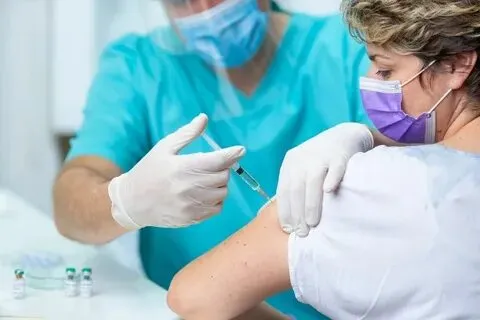Fall is flu season, and getting vaccinated remains one of the most important steps people can take to protect themselves and their communities. With flu vaccines now available nationwide, many individuals are wondering about the best timing, eligibility requirements, and what to expect from this year’s vaccination options.
Everyone 6 months and older should get a flu vaccine every season, with rare exceptions, according to health officials. The 2025-26 flu season is expected to be moderate compared to last year, but vaccination still provides crucial protection against serious complications, hospitalizations, and even death from influenza.
Understanding the different vaccine types, optimal timing for vaccination, and where to get immunized can help people make informed decisions about their health this fall. Whether someone is considering their first flu shot or needs guidance on the best options for their age group, knowing the facts about flu vaccination ensures better protection throughout the upcoming season.
Who Should Get a Flu Shot This Fall
The CDC recommends flu vaccination for nearly everyone 6 months and older, with specific guidance for children, older adults, and high-risk populations. Annual vaccination provides the best protection against influenza and its potentially serious complications.
CDC Recommendations and Eligibility
The Centers for Disease Control and Prevention recommends that everyone 6 months and older receive an annual flu vaccine. This universal recommendation has been in place since the 2010 flu season.
People who should get vaccinated include:
- All healthy children and adults
- Pregnant women at any stage of pregnancy
- Healthcare workers and caregivers
- People with chronic medical conditions
The CDC makes rare exceptions for certain individuals. People with severe allergies to vaccine components or those who have had serious reactions to previous flu shots should consult their healthcare provider.
Most standard flu vaccines are approved for people 6 months and older. Different vaccine types have specific age ranges and eligibility requirements.
Flu Shots for Children and Older Adults
Children 6 months through 8 years may need two doses during their first flu vaccination season. The first dose should be given as early as possible since the second dose must be administered at least four weeks later.
For adults 65 years and older, the CDC preferentially recommends three specific vaccines: Fluzone High-Dose, Flublok Recombinant, or Fluad Adjuvanted. These vaccines contain higher antigen levels or adjuvants to create stronger immune responses in older adults.
Children under 2 years and adults over 65 face higher risk for severe flu complications and hospitalization. Early vaccination provides crucial protection for these vulnerable age groups.
If preferred vaccines for seniors aren’t available, any age-appropriate flu vaccine should be used instead.
Annual Vaccination for High-Risk Groups
People with chronic health conditions face increased risk for severe flu complications requiring hospitalization. High-risk conditions include:
- Asthma and chronic lung disease
- Heart disease and diabetes
- Kidney and liver disorders
- Weakened immune systems
- Neurological conditions
Pregnant women should get their flu shots during any trimester. Vaccination during pregnancy protects both mother and baby, providing antibodies that protect infants during their first months of life.
Healthcare workers and caregivers should prioritize vaccination to protect patients and vulnerable populations they serve. Annual vaccination remains essential because immunity decreases over time and flu viruses change each year.
People at higher risk for severe illness should get vaccinated by the end of October for optimal protection during peak flu season.
When and Where to Get Your Flu Shot
Getting vaccinated before flu activity peaks in your community provides optimal protection for the 2025-2026 flu season. Most pharmacies, medical centers, and clinics now offer flu shots with convenient scheduling options.
Best Time to Schedule Your Vaccination
September through early October represents the ideal vaccination window for most people. The vaccine takes about two weeks to build full immunity in your system.
Getting vaccinated in September ensures strong protection that lasts throughout fall and winter. This timing provides coverage before flu activity typically increases in most communities.
People who miss the early window should still get vaccinated through October and beyond. Vaccination remains beneficial even after flu season begins since influenza circulates until April in many areas.
Healthcare providers recommend getting the flu shot as soon as it becomes available rather than waiting. Early vaccination eliminates the risk of forgetting or encountering supply shortages later.
Typical Flu Season Timeline
Flu season officially runs from October through May with predictable patterns of activity. Cases typically begin rising in October across most regions.
Peak flu activity usually occurs between December and February. However, timing varies by geographic location and year-to-year circulation patterns.
The 2025-2026 season will likely follow similar patterns to previous years. Flu activity can start earlier or later depending on viral strains and community factors.
Getting vaccinated before the end of October ensures protection during the critical early months. Even late vaccination provides valuable protection through winter and spring.
Availability at Pharmacies, Clinics, and Medical Centers
Flu shots are widely available at multiple convenient locations starting in early fall. Most major pharmacy chains offer walk-in and appointment-based vaccinations.
Common vaccination sites include:
- Retail pharmacies (CVS, Walgreens, Rite Aid)
- Grocery store pharmacies
- Urgent care centers
- Primary care physician offices
- Community health clinics
Medical centers like Big Apple Medical Care provide comprehensive flu vaccination services alongside other preventive care options. Many locations offer extended hours to accommodate different schedules.
Most insurance plans cover flu shots at no cost when received at in-network providers. Uninsured individuals can expect costs ranging from $20 to $100 depending on location and vaccine type.
Types of Flu Vaccines and What to Expect
Several vaccine options are available to protect against flu strains, each designed for specific age groups and health conditions. The standard trivalent flu vaccines protect against three influenza viruses, while specialized formulations offer enhanced protection for certain populations.
Standard Flu Shot Options
Most people receive the standard inactivated flu vaccine, which is given as an injection in the arm. The trivalent flu vaccine protects against three different influenza Type A and B viruses that researchers predict will be most common during the flu season.
Cell-based vaccines like Flucelvax offer an egg-free alternative for those with egg allergies. This vaccine is grown in mammal cell culture instead of hen eggs and is approved for people 6 months and older.
The Flublok vaccine uses recombinant technology and contains three times more antigen than standard vaccines. This production method doesn’t require egg-grown vaccine virus, making it another option for people with egg sensitivities.
Some locations offer jet injector delivery for adults aged 18-64, though traditional needle administration remains the most common method. Children and adults over 64 must receive needle-administered vaccines.
Nasal Spray Flu Vaccine
The nasal spray flu vaccine (FluMist) provides an injection-free option for eligible patients. This live attenuated influenza vaccine contains weakened flu viruses and is approved for healthy individuals aged 2-49 years.
Children often prefer this needle-free option, though not all children can receive it. The nasal spray vaccine is not recommended for pregnant women, immunocompromised individuals, or people with certain chronic conditions like asthma or heart disease.
Healthcare providers administer the nasal spray vaccine by spraying half the dose into each nostril. Patients should expect mild side effects like runny nose, headache, or low-grade fever. The weakened viruses in the vaccine cannot cause flu illness in healthy recipients.
Special Recommendations for Older Adults
Adults 65 and older have access to enhanced flu vaccines designed to create stronger immune responses. Fluzone High-Dose contains four times the standard antigen amount to compensate for age-related immune system changes.
The Fluad adjuvanted flu vaccine includes a special ingredient called an adjuvant that boosts immune response. Both vaccines are specifically licensed for seniors and have shown improved effectiveness compared to standard vaccines in this age group.
Older adults should discuss vaccine options with their healthcare providers to determine the most appropriate choice. These enhanced formulations help address the increased flu complications risk that comes with aging, including higher rates of hospitalization and severe illness.
Flu Shot Effectiveness, Safety, and Other Considerations
The 2025-2026 flu vaccine provides protection against three influenza viruses expected to circulate this season, with effectiveness varying by year and individual factors. Understanding potential side effects, vaccine interactions, and coverage options helps people make informed decisions about their annual flu vaccination.
How the Flu Shot Protects Against the Virus
The flu vaccine works by exposing the immune system to inactivated virus particles or proteins that resemble influenza viruses. This exposure prompts the body to produce antibodies that recognize and fight the actual flu virus if encountered later.
Vaccine effectiveness typically ranges from 40-60% when the vaccine is well-matched to circulating viruses. The 2025-2026 flu vaccines target three specific influenza strains that researchers predict will be most common this season.
The vaccine provides several layers of protection:
- Primary prevention: Reduces risk of contracting influenza
- Severity reduction: Lessens symptoms and duration if infection occurs
- Hospitalization prevention: Decreases risk of severe complications requiring medical care
Protection begins approximately two weeks after vaccination when antibody levels reach their peak. Annual vaccination remains necessary because influenza viruses constantly mutate and immunity wanes over time.
The Centers for Disease Control and Prevention emphasizes that even partial protection significantly reduces community transmission and protects vulnerable populations through herd immunity.
Potential Side Effects and Safety
Most people experience mild or no side effects from the flu shot. The Food and Drug Administration has approved flu vaccines with extensive safety data spanning decades of use.
Common side effects include:
- Soreness, redness, or swelling at injection site
- Low-grade fever
- Headache
- Muscle aches
- Nausea
These reactions typically resolve within 1-2 days and indicate the immune system is responding appropriately to the vaccine.
Serious adverse events are rare:
- Severe allergic reactions occur in fewer than 1 in 1 million doses
- Guillain-Barré syndrome affects 1-2 people per million vaccinated
- The vaccine cannot cause flu illness since it contains inactivated virus
People with egg allergies can safely receive flu vaccines regardless of allergy severity. Previous restrictions requiring medical supervision have been removed for most individuals.
Those who should consult healthcare providers before vaccination include people with previous severe vaccine reactions or those currently experiencing acute illness.
Co-Administration with COVID-19 Vaccines
The flu shot and COVID-19 vaccine can be administered simultaneously without reducing effectiveness or increasing side effects. Both vaccines target different viruses and do not interfere with each other’s immune response.
Healthcare providers recommend getting both shots at the same time if someone is due for both vaccines. This approach maximizes protection against respiratory illnesses that commonly circulate during fall and winter months.
Administration guidelines:
- Vaccines should be given in different arms when possible
- Same-day administration does not require spacing between doses
- Side effects may be slightly more noticeable but remain mild
The COVID-19 shot and annual flu vaccine serve complementary roles in preventing serious respiratory illness. Both diseases can cause hospitalization and complications, particularly in older adults and those with underlying health conditions.
People should maintain their regular vaccination schedules for both COVID-19 and influenza rather than delaying either vaccine.
Cost and Insurance Coverage
Most insurance plans cover flu vaccines at no cost to patients under preventive care benefits. The Affordable Care Act requires insurance companies to cover recommended vaccines without copayments or deductibles.
Coverage typically includes:
- Annual flu shots for everyone 6 months and older
- Administration fees
- No prior authorization requirements
Uninsured individuals can access low-cost vaccines through:
- Community health centers
- Local health departments
- Pharmacy discount programs
- Federally Qualified Health Centers
Medicare Part B covers flu vaccines completely, while Medicaid coverage varies by state but generally includes flu shots. Most employer-sponsored health plans also provide full coverage for annual influenza vaccination.
People should verify their specific coverage details with their insurance provider, though out-of-pocket costs rarely exceed $30-50 at retail pharmacies for those paying directly.
Frequently Asked Questions
The timing, effectiveness, and benefits of flu vaccination often raise questions for patients seeking optimal protection. These answers address common concerns about vaccination schedules, protection duration, and seasonal considerations.
What is the optimal month to receive the flu vaccine for maximum effectiveness?
September and October represent the ideal vaccination window for most adults, with completion by the end of October recommended for optimal protection.
How late in the flu season can I get vaccinated and still receive benefits?
Vaccination remains beneficial even late in the season, as flu activity can continue through spring, though protection takes two weeks to develop after vaccination.
What are the expected effectiveness rates of the 2025 flu vaccine?
Flu vaccine effectiveness varies annually based on the match between vaccine strains and circulating viruses, typically ranging from 20% to 60% when well-matched.
Are there specific reasons to consider getting vaccinated against the flu this fall?
Everyone 6 months and older should receive annual flu vaccination to reduce illness risk, hospitalizations, and death, with particular importance for high-risk individuals.
Can receiving a flu shot in August provide protection for the entire flu season?
August vaccination may provide season-long protection for children needing two doses, though adults 65 and older should avoid early vaccination due to potentially waning immunity.
What precautions should be taken following the administration of a flu shot?
Patients should monitor for severe allergic reactions within 15 minutes of vaccination and report any unusual symptoms to their healthcare provider promptly.







